What are efflorescence and how to remove them?

White stains, salt deposits that have crystallized from the water in concrete or bricks are called efflorescence. Most people try to fight them, and some try to use them for decorative purposes.


What it is?
Efflorescence on concrete has the appearance of efflorescence that arose during the use of the wall, as well as under the influence of moisture, dust and constant changes in temperature conditions. When it is dry and hot outside, the water from the facade evaporates, and the salt it contains crystallizes and turns into stains.
Salt inclusions can appear on plaster, stone, wood, concrete, and are found on walls and windows. They form on vertical and horizontal surfaces such as paving stones or concrete paths. Plaques can be of several varieties:
- primary - with a large percentage of calcium hydroxide or calcium carbonate;
- secondary - arises from the old age of concrete or its long-term use.
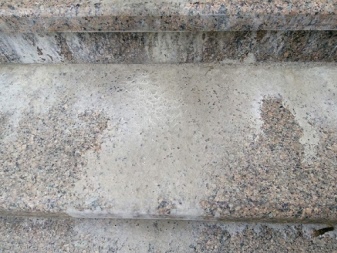
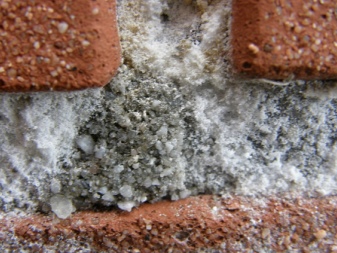
Saline inclusions can have both a solid and a loose structure. According to many experts, efflorescence and traces of moisture need to be removed, since they lead to the appearance of microcracks in the brickwork or the destruction of facades. If there are efflorescences on the wall, the craftsmen will not be able to apply a layer of finishing materials to it. It can also cause plaster and primer to flake off.
In some cases, salt stains on concrete can play an aesthetic role. On sale sometimes there are materials with an aged appearance, which is given to it by efflorescence. The surface of such a material is characterized by an ash tint and the presence of white salt inclusions.
To obtain a warm brick tone, manufacturers add iron oxide pigment to the cement mixture.
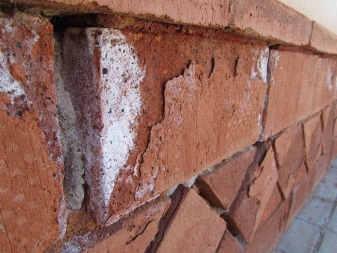
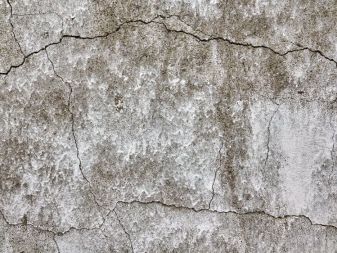
Reasons for the appearance
Common causes of salt stains on concrete include the following.
- High humidity. Most often, the occurrence of plaque is observed in a closed room with high humidity, where regular ventilation is not carried out.
- The presence of salts in the water. In case of contact with a liquid containing undissolved salts, absorption occurs. Over time, the liquid fraction evaporates, and the solid comes out and forms white spots.
- The presence of lime in the solution. In this case, the reaction of calcium hydroxide and CO2 is observed.
- Corrosion of a chemical nature. There is a large amount of industrial gas in the atmosphere. Over time, the latter settles and forms efflorescence.
- Poor insulation quality. The presence of hollow insulation entails the penetration of groundwater into the concrete, which contains salts.
- Precipitation. Precipitation saturates concrete with moisture, which contains undissolved types of salts.
- Low ambient temperature. Lack of heat, as well as changes in temperature conditions, entail salt emissions on the concrete surface.
- Violation of the technology for the production and storage of concrete products.
- Ignoring requirements and rules during construction.
- Absence or small amount of pozzolanic substances in the concrete solution.
- Low density or high porosity of the cast product.
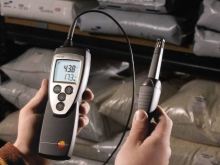
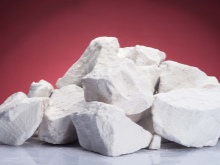
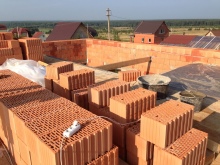
Remedies
It is possible to remove efflorescence inside the room or outside the facade not only by chemical, but also by folk remedies. The salts that dissolve in water include chlorides, sulfates, potassium and sodium salts. They can be removed from the walls with plain water and minimal physical effort. Poorly soluble salts are carbonate salts, as well as phosphates of calcium, iron, aluminum, barium sulfates, calcium silicates.
Often, hard-to-dissolve salt compounds can be found on brick and concrete surfaces. To eliminate them, you will need to use special chemical-based cleaning agents. Since no one can say with certainty about the characteristics of efflorescence, the method of exclusion is often used to eliminate them. Fortunately, a wide range of substances can be found in hardware stores today that help eliminate plaque.
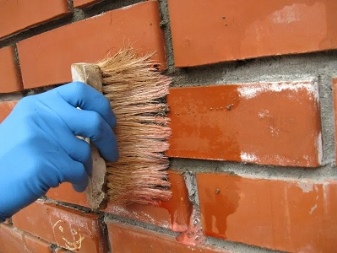
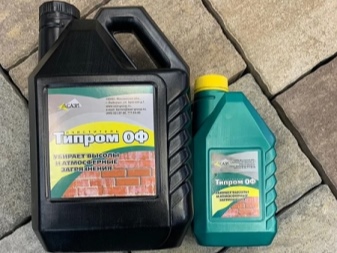
To carry out tests, it is recommended to buy several types of efflorescence cleaning agents in small packages and test them on a small section of the facade. Application is carried out with rollers or brushes, then kept for half an hour and washed off with liquid. Further, the treated areas should be examined and determined which tool did the job better. When using special cleaners, craftsmen should protect themselves with glasses and rubber gloves. In case of contact with any part of the body, you should immediately rinse the area with clean water and thereby prevent chemical burns.
The result of removing efflorescence must be fixed - for this, the walls are treated with a special impregnation called a water repellent. This product removes the base and prevents plaque re-formation. This event should be carried out immediately after the brickwork has dried.
Experts recommend treating the facade with a water repellent immediately after the cement mortar has dried. Thus, the craftsmen will not need to spend time and effort fighting efflorescence.
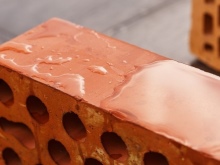
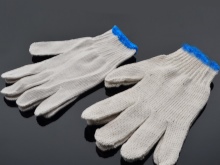
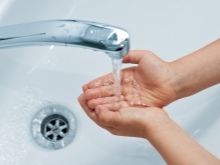
Quite a lot of compositions for the elimination of salt stains are known. Silicone water repellents have proven themselves well. As a result of their use, a protective siliconized film is formed, it prevents the penetration of moisture into the masonry. In addition, these substances contribute to the "breathing" of the walls and natural gas exchange. Treatment with such substances reduces the contamination of the facade and stops the formation of mildew and mold on surfaces.
The information for these products indicates that after processing, they protect the facades for about 10 years. Reapplication of the water repellent is required if the walls get wet from rain. In some cases, re-treatment is carried out 5 years after the first application. The surface must be processed until the agent is absorbed. After that, it is worth reapplying. Before applying to the masonry, the water repellent must be diluted in water, according to the instructions. It is impossible to eliminate re-plaque by increasing the concentration, as this can cause a reverse reaction.
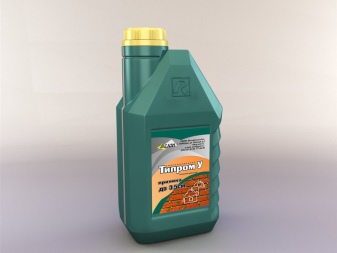
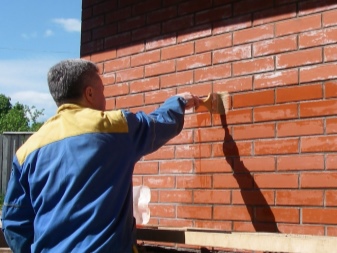
To eliminate salt deposits from the facade, you can use the following folk methods:
- treatment with acetic acid - as a result of the work, an easily soluble plaque is obtained, which can be washed off with water;
- mechanically - using the usual detergents, brushes and a large amount of unsalted water, you can try to remove plaque;
- diluted phosphoric acid.
The industrial substance Trilon B (chelaton III) is considered a super-remedy for removing salt stains on masonry. It has been shown to be highly effective in combating insoluble salt from a steam boiler or heat generating plant. Trilon at a high speed makes it easy to dissolve from a sparingly soluble salt. After 15 minutes have passed since the application of the product, the surface will need to be rinsed with hot water.


Prevention methods
As practice has shown, efflorescence is better prevented than eliminated later. Therefore, when planning the construction of any building, craftsmen should remember the following rules.
- Before starting work, the brick should be stored in a room where precipitation does not fall.
- During construction, do not forget about good waterproofing of the foundation.
- Freshly erected walls should not be left uncovered during the frosty season.
- Brickwork should not be carried out in the rain. The lined wall should be covered with foil.
- Do not add an excessive amount of additives, accelerators, antifreeze agents. The volume of the above substances should not be higher than the norm indicated in the instructions.
- It is not recommended to soak the brick in liquid before laying. Also, do not use too thin cement mortar. And the solution that got on the bricks must be quickly eliminated.
- After completing the construction of the wall, it is required to treat it with water-repellent agents.
When working with facing masonry, the master should be extremely careful, since by washing out efflorescence, you can remove the coloring pigments from the brick. The result of such work can be an unattractive wall of uneven color.
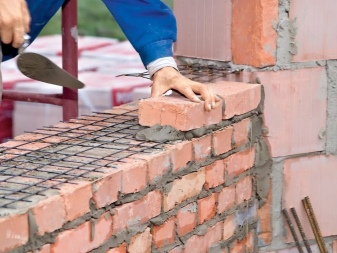
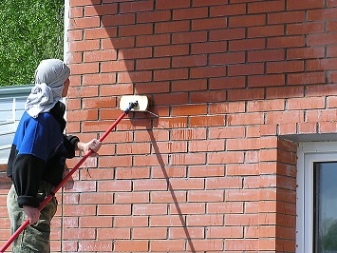
For information on how to properly remove efflorescence on a brick, see the next video.













The comment was sent successfully.